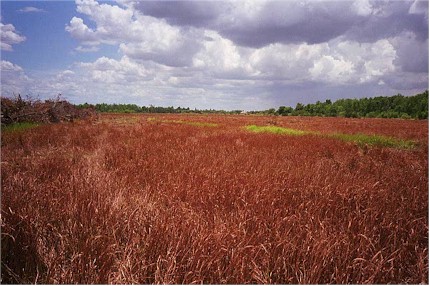 Whether it is using our eucalyptus and cottonwood trees for (A) commercial forestry or (B) as a "bridge crop" to establish native uplands -- stabilizing the forest floor with native plants to control cogongrass is critical.
Whether it is using our eucalyptus and cottonwood trees for (A) commercial forestry or (B) as a "bridge crop" to establish native uplands -- stabilizing the forest floor with native plants to control cogongrass is critical.
Remember that at initial development as a tree farm, the site was a prairie of cogongrass (and not much else).

Please Note: Species of plants that are currently very dominant on the Tree Farm are highlighted in Blue.
Harmful Non-Native and Native Plants Currently Present
Beneficial Natives Currently Present
| Common Name:
|
Scientific Name |
Comments |
|---|
| Creeping Dayflower | Commelina diffusa
| Very first native pioneers dominant in understory. |
| Southern Shield Fern | Thelypteris kunthii
| Appeared after 2nd year. Now very prevalent in understory |
| Saltbush |
Baccharis halimifolia
|
Becoming prevalent in understory |
| Bluestem | Andropogon
|
Present but not common |
| Shy-leaf | Aeschynomena americana
|
Pea family. Present but not common. |
| Red Maple | Acer rubrum
|
Seedlings very prevalent, but not growing to trees |
| Virginia Creeper | Parthenocissus quinquefolia
| Present, but more common in sunny areas. |
| Elderberry | Sambucus canaensis
| Rare, but in sunny, open, and wet areas. |
| Pepper Vine | Ampelopsis arborea
| Appears to co-habitat with trees better than other vines. |
| Spanish Needle | Bidens alba
| Very common, may explain large butterfly population. |
| American Beautyberry | Callicarpa americana
| Started appearing in 2nd year -- very random. |
Initially Dominant Sun Loving Plants Now Disappearing In Shaded Tree Understory
| Common Name:
|
Scientific Name |
Comments |
|---|
| Primrose Willow | Ludwigia peruviana
| Dwarfs growth in young trees, but does not appear to cause mortality. |
| Wild Bush Bean | Macroptilium lathyroides
| While very dominant, does not appear to cause significant tree mortality |
| Bahia-grass |
Paspalum notatum
|
Appears helpful with initial weed control. |
| Bermuda-rass | Cynodon dactylon
|
Appears helpful with initial weed control. |
| Showy Rattlebox | Crotalaria spectabilis
|
Does not appear to harm young trees. |
|
Additional Native Flora Identified by UF Botantists
Additional Species: The Florida Institute of Phosphate Research (FIPR) has also identified the following plants in tree understory: Foxgrape, Figfruit, Smartweed, Pokeweed, Ragweed, Dog Fennel.
Natives Re-introduction Project: Advisors (Cargill, Florida Department of Environmental Protections, and the Natives Nursery) have provided the following list of native plants and grasses that will comprise our "test plots" on and between tree beds:
Lizard's tail, Saururus cernuus
Pennywort, Hydrocotyle sp.
Muhly grass, Muhlenbergia capillaris
Wiregrass, Aristida berhychiana
Chapman's Goldenrod
Beakrush, Rhynchospora sp.
Cord grass, Spartina sp.
Panicum anceps
Panicum longifolium
Eastern gamagrass Tripsacum dactyloides
Maidencane Panicum haemotomen
Short-topped goldenrod Euthamia minor
Aster elliotii
Goldenrod Solidago fistulosa
Winged Shumac Rhus copallina
Blackberry Rubus arbutifolia
Andropogon spp.
Wildlife Returning to Site: Prior to the development of our environmentally damaged phosphate mining site (when it was totally dominated by ~6 feet of cogongrass), birds were rarely seen. Perhaps one of the most gratifying accomplishments is seeing how significant levels of bird populations are returning to site.
While we are very much in a learning phase of fully understanding the "whys" of increased wildlife populations-- certain aspects are clear. For example, with tree canopies shading the forest floor, cogongrass is being effectively controlled. This is allowing native Florida plants such as creeping dayflower (a favorite bard source, especially to Ground Doves) to return to the site. We also are observing tremendous numbers of tree frogs in eucalyptus stands.
Birds
Osprey -- Spring, Summer, Fall Resident. Red Tail Hawk - [pictures]
Red Shouldered Hawk
Common Ground Dove
Redwing Blackbird
Turkey and Black Vultures
Northern Mockingbird -- only along perimeter of farm.
Sandpiper -- Winter Resident.
Ibis
Sandhill Crane
Baltimore Oriole -- Winter Resident.
Egret
Northern Cardinal -- increasing populations.
Yellow-Throated and Palm Warbler -- Winter Resident.
Blue-gray Gnatcatcher
Eastern Phoebe
American Robin -- Winter Resident.
Common Grackle
Wood Stork -- found in wet areas.
Carolina Wren
Swallow-tail Kite -- Beautiful!, 1st siting on Farm May 2003.
Butterflys:
Monarch or Viceroy -- (We are not sure)
Zebra Longwing -- State Butterfly of Florida
Snakes:
Black Racer -- most common snake on farm.
Red Rat/Corn Snake -- Very docile and pretty snake.
King Snake
Indigo Snake -- Wow, around 7 to 8' in length!
Cottonmouth -- Common and very agressive snake.
Rattlesnake -- Not common, but are on tree farm.
Large Critters:
Bobcats
Wild Hogs
Alligators
Florida Panther -- One siting in February, early morning.
|
 |



